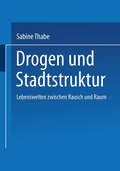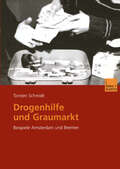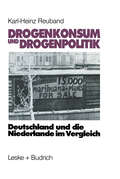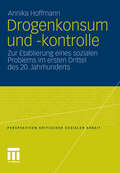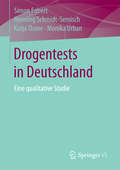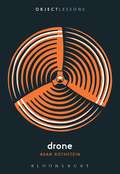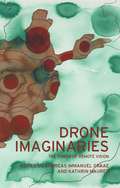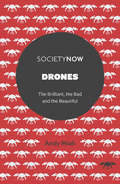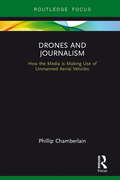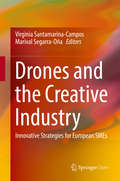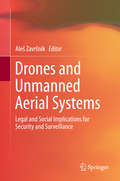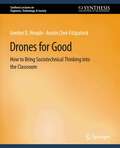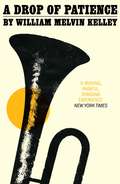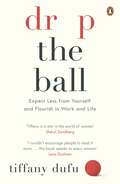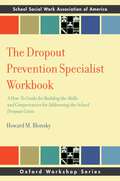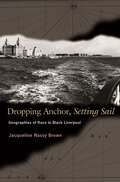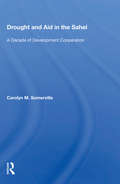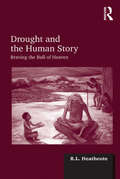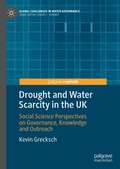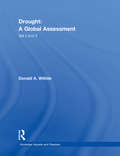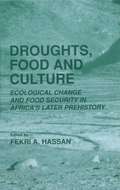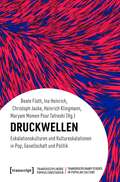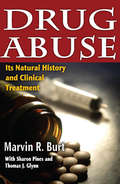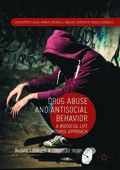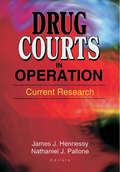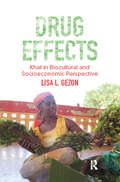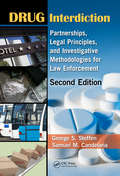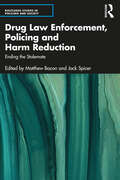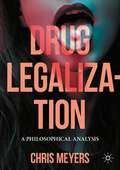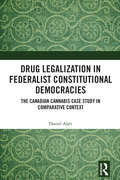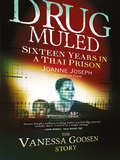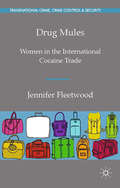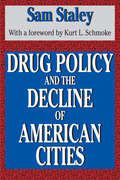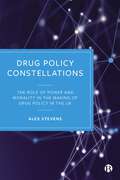- Table View
- List View
Drogenhilfe und Graumarkt: Beispiele Amsterdam und Bremen
by Torsten SchmidtDas Buch beschäftigt sich für Deutschland erstmalig mit einem bisher in der wissenschaftlichen Drogenforschung separat nicht bearbeiteten Feld der Drogenproblematik, dem Straßenverkauf von Substitutionsmitteln und Psychopharmaka auf der Drogenszene. Angesichts der momentanen Diskussion um die sogenannten "Methadon-Toten" ein aktuelles Thema. Gleichwohl fragt das Buch nach dem Nutzen und dem Risiko dieser in der Drogenhilfe ungewünschten Selbstmedikation für Drogenkonsumenten.
Drogenkonsum und Drogenpolitik: Deutschland und die Niederlande im Vergleich
by Karl-Heinz ReubandEs zählt zu den Merkwürdigkeiten der neueren Diskussion, wie sehr das Drogenphänomen als länderübergreifendes Problem wahrgenommen wird und wie wenig gleichzeitig über die Drogenproblematik und Drogenpolitik in anderen Ländern bekannt ist. Bloße Annahmen, die wie gesicherte wis senschaftliche Erkenntnisse behandelt und nicht mehr hinterfragt werden, bestimmen die Diskussion. Wohl nirgends wird dies deutlicher als im Fall der Bundesrepublik Deutschland und der Niederlande. Beide Länder verfol gen gegenüber dem Drogengebrauch eine unterschiedliche Strategie: Wäh rend in der Bundesrepublik der Besitz und Erwerb von Cannabis strafrecht lich geahndet wird, wird in den Niederlanden eine Politik der Tolerierung, ja gar der gesellschaftlichen Akzeptanz betrieben. Aus Sicht vieler, wenn nicht gar der meisten bundesdeutschen Autoren, muß eine derartige liberale Politik zwangsläufig den Drogengebrauch und drogenbedingte Probleme begünstigen. Doch aus Sicht vieler holländischer Autoren bewirkt sie genau das Gegenteil: eine Abnahme der Konsumentenzahlen, eine Trennung des Marktes für weiche und harte Drogen und eine Reduktion drogenbedingter Probleme. Die Selbstverständlichkeit, mit der in den beiden Ländern die eigenen Deutungen vorgebracht werden, ist bemerkenswert. Daß sie im Wider spruch zu den Deutungen in anderen Ländern -gar des Nachbarlande- stehen, wird in der Regel nicht zur Kenntnis genommen. Weder gibt es eine Diskussion über die unterschiedlichen "Realitäts"beschreibungen noch deren Überprüfung anhand empirischer Belege. Maßgeblich verantwortlich für diese Situation ist die verbreitete Neigung, den Drogengebrauch auch dort primär unter einer wertgeladenen Perspektive zu sehen, wo es um Sachaussagen gehl Argumente moralischer und politischer Natur ersetzen unter diesen Umständen die wissenschaftliche Auseinandersetzung.
Drogenkonsum und -kontrolle: Zur Etablierung eines sozialen Problems im ersten Drittel des 20. Jahrhunderts (Perspektiven kritischer Sozialer Arbeit)
by Annika HoffmannVerbreiteter Drogenkonsum gehört in das populäre und wissenschaftliche Bild der Weimarer Republik: Es heißt, in den 1920er Jahren habe eine 'Drogenwelle' Deutschland überrollt. Annika Hoffmann zeigt, wie sich zu Beginn des 20. Jahrhunderts die Deutung des nicht-medizinischen Konsums von Opiaten und Kokain als soziales Problem etablierte und welche Folgen dies für die Konsumenten hat. Die Autorin setzt sich intensiv mit historischen Quellen auseinander und zeigt am problematisierenden Diskurs der Zeitgenossen, wie sich der heute hegemoniale Blick auf Drogen entwickelte und welche Schlussfolgerungen daraus für den Umgang mit Drogen und ihren Konsumenten heute gezogen werden können.
Drogentests in Deutschland: Eine qualitative Studie
by Simon Egbert Henning Schmidt-Semisch Katja Thane Monika UrbanDas Buch nimmt eine qualitative Bestandsaufnahme von Drogentestanwendungen in Deutschland vor und fragt dabei nach ihren Kontexten, ihrer Durchführung und ihren Folgen. Von besonderem Interesse ist dabei die Frage nach den spezifischen Intentionen (Anwendungsrationalitäten) der jeweiligen Drogenkonsumkontrollen, die für unterschiedliche soziale Felder – Soziale Arbeit, Schule und Arbeitsplatz – vertiefend untersucht werden. Zugleich werden kontextspezifische und -übergreifende Folgen für die getesteten Individuen und die Wirkungen der Testpraxen auf die Anwendungskontexte selbst beschrieben und analysiert.
Drone (Object Lessons)
by Adam RothsteinObject Lessons is a series of short, beautifully designed books about the hidden lives of ordinary things. Drones are in the newspaper, on the TV screen, swarming through the networks, and soon, we're told, they'll be delivering our shopping. But what are drones? The word encompasses everything from toys to weapons. And yet, as broadly defined as they are, the word "drone†? fills many of us with a sense of technological dread. Adam Rothstein cuts through the mystery, the unknown, and the political posturing, and talks about what drones really are: what technologies are out there, and what's coming next; how drones are talked about, and how they are represented in popular culture.It turns out that drones are not as scary as they appear-but they are more complicated than you might expect. Drones reveal the strange relationships that humans are forming with their new technologies.Object Lessons is published in partnership with an essay series in the The Atlantic.
Drone (Object Lessons)
by Adam RothsteinObject Lessons is a series of short, beautifully designed books about the hidden lives of ordinary things. Drones are in the newspaper, on the TV screen, swarming through the networks, and soon, we're told, they'll be delivering our shopping. But what are drones? The word encompasses everything from toys to weapons. And yet, as broadly defined as they are, the word “drone” fills many of us with a sense of technological dread. Adam Rothstein cuts through the mystery, the unknown, and the political posturing, and talks about what drones really are: what technologies are out there, and what's coming next; how drones are talked about, and how they are represented in popular culture.It turns out that drones are not as scary as they appear-but they are more complicated than you might expect. Drones reveal the strange relationships that humans are forming with their new technologies.Object Lessons is published in partnership with an essay series in the The Atlantic.
Drone imaginaries: The power of remote vision
by Andreas Immanuel Graae and Kathrin MaurerThere should no longer be any doubt: drones are here to stay. In civil society, they are used for rescue, surveillance, transport and leisure. And on the battlefield, their promises of remote protection and surgical precision have radically changed the way wars are fought. But what impact are drones having on our identity, and how are they affecting the communities around us? This book addresses these questions by investigating the representation of civilian and military drones in visual arts, literature, and architecture. What emerges, the contributors argue, is a compelling new aesthetic: ‘drone imaginary’, a prism of cultural and critical knowledge, through which the complex interplay between drone technology and human communities is explored, and from which its historical, cultural and political dimensions can be assessed. The contributors offer diverse approaches to this interdisciplinary field of aesthetic drone imaginaries. With essays on the aesthetic configurations of drone swarming, historical perspectives on early unmanned aviation, as well as current debates on how drone technology alters the human body and creates new political imaginaries, this book provides new insights to the rapidly evolving field of drone studies. Working across art history, literature, photography, feminism, postcolonialism and cultural studies, Drone imaginaries offers a unique insight into how drones are changing our societies.
Drone imaginaries: The power of remote vision
by Andreas Immanuel Graae Kathrin MaurerThere should no longer be any doubt: drones are here to stay. In civil society, they are used for rescue, surveillance, transport and leisure. And on the battlefield, their promises of remote protection and surgical precision have radically changed the way wars are fought. But what impact are drones having on our identity, and how are they affecting the communities around us? This book addresses these questions by investigating the representation of civilian and military drones in visual arts, literature, and architecture. What emerges, the contributors argue, is a compelling new aesthetic: ‘drone imaginary’, a prism of cultural and critical knowledge, through which the complex interplay between drone technology and human communities is explored, and from which its historical, cultural and political dimensions can be assessed. The contributors offer diverse approaches to this interdisciplinary field of aesthetic drone imaginaries. With essays on the aesthetic configurations of drone swarming, historical perspectives on early unmanned aviation, as well as current debates on how drone technology alters the human body and creates new political imaginaries, this book provides new insights to the rapidly evolving field of drone studies. Working across art history, literature, photography, feminism, postcolonialism and cultural studies, Drone imaginaries offers a unique insight into how drones are changing our societies.
Drones: The Brilliant, the Bad and the Beautiful (SocietyNow)
by Andy MiahAgainst the backdrop of an increasingly dynamic world, driven by rapid digital innovation and technological advances, drones are becoming prolific within society. In this book, Andy Miah delivers a comprehensive analysis of the wide-reaching applications of drones, as well as a critical interrogation of the social, cultural and moral issues that they provoke. Delving into philosophical discussions about the implications of drone technology, this book shines a light on their real-world applications, the challenges they pose, and what they reveal about the human condition, when faced with a future of autonomous, intelligent robots.
Drones: The Brilliant, the Bad and the Beautiful (SocietyNow)
by Andy MiahAgainst the backdrop of an increasingly dynamic world, driven by rapid digital innovation and technological advances, drones are becoming prolific within society. In this book, Andy Miah delivers a comprehensive analysis of the wide-reaching applications of drones, as well as a critical interrogation of the social, cultural and moral issues that they provoke. Delving into philosophical discussions about the implications of drone technology, this book shines a light on their real-world applications, the challenges they pose, and what they reveal about the human condition, when faced with a future of autonomous, intelligent robots.
Drones and Journalism
by Phil ChamberlainDrones and Journalism explores the increased use of unmanned aerial vehicles, or drones, by the global media for researching and newsgathering purposes. Phil Chamberlains examines the technological development and capabilities of contemporary drone hardware, whilst also exploring the use of drones in investigative reporting, in the reporting of humanitarian crisis, and the use of this new technology in more mainstream media practices. The book also analyses the complex place of the media’s drone use in relation to international laws, as well as the ethical challenges and issues raised by the practice.
Drones and Journalism: The All Seeing Eye (Routledge Focus On Journalism Studies #4)
by Phil ChamberlainDrones and Journalism explores the increased use of unmanned aerial vehicles, or drones, by the global media for researching and newsgathering purposes. Phil Chamberlains examines the technological development and capabilities of contemporary drone hardware, whilst also exploring the use of drones in investigative reporting, in the reporting of humanitarian crisis, and the use of this new technology in more mainstream media practices. The book also analyses the complex place of the media’s drone use in relation to international laws, as well as the ethical challenges and issues raised by the practice.
Drones and the Creative Industry: Innovative Strategies for European SMEs
by Marival Segarra-Oña Virginia Santamarina-CamposThis open access, interdisciplinary book presents innovative strategies in the use of civil drones in the cultural and creative industry. Specially aimed at small and medium-sized enterprises (SMEs), the book offers valuable insights from the fields of marketing, engineering, arts and management. With contributions from experts representing varied interests throughout the creative industry, including academic researchers, software developers and engineers, it analyzes the needs of the creative industry when using civil drones both outdoors and indoors. The book also provides timely recommendations to the industry, as well as guidance for academics and policymakers.
Drones and Unmanned Aerial Systems: Legal and Social Implications for Security and Surveillance
by Aleš ZavršnikThis book tackles the regulatory issues of Unmanned Aerial Systems (UAS) or Remotely-Piloted Aerial Systems (RPAS), which have profound consequences for privacy, security and other fundamental liberties. Collectively known as “drones,” they were initially deployed for military purposes: reconnaissance, surveillance and extrajudicial executions. Today, we are witnessing a growth of their use into the civilian and humanitarian domain. They are increasingly used for goals as diverse as news gathering, aerial inspection of oil refinery flare stacks, mapping of the Amazonian rain-forest, crop spraying and search and rescue operations. The civil use of drones is becoming a reality in the European Union and in the US.The drone revolution may be a new technological revolution. Proliferation of the next generation of “recreational” drones show how drones will be sold as any other consumer item. The cultural perception of the technology is shifting, as drones are increasingly being used for humanitarian activities, on one hand, but they can also firmly be situated in the prevailing modes of postmodern governance on the other hand. This work will be of interest to researchers in Criminology and Criminal Justice interested in issues related to surveillance, security, privacy, and technology. It will also provide a criminological background for related legal issues, such as privacy law, aviation law, international criminal law, and comparative law.
Drones for Good: How to Bring Sociotechnical Thinking into the Classroom (Synthesis Lectures on Engineers, Technology, & Society)
by Gordon D. Hoople Austin Choi-FitzpatrickWhat in the world is a social scientist doing collaborating with an engineer, and an engineer with a sociologist, and together on a book about drones and sociotechnical thinking in the classroom? This book emerges from a frustration that disciplinary silos create few opportunities for students to engage with others beyond their chosen major. In this volume, Hoople and Choi-Fitzpatrick introduce a sociotechnical approach to truly interdisciplinary education around the exciting topic of drones. The text, geared primarily at university faculty, provides a hands-on approach for engaging students in challenging conversations at the intersection of technology and society. Choi-Fitzpatrick and Hoople provide a turnkey solution complete with detailed lesson plans, course assignments, and drone-based case studies. They present a modular framework, describing how faculty might adopt their approach for any number of technologies and class configurations.
A Drop of Patience
by William Melvin KelleyAt the age of five, a blind African-American boy is handed over to a brutal state home. Here Ludlow Washington will suffer for eleven years, until his prodigious musical talent provides him an unlikely ticket back into the world.The property of a band, playing for down-and-outs in a southern dive, Ludlow's pioneering flair will take him to New York and the very top of the jazz scene - where his personal demons will threaten to drag him back down to the bottom.A Drop of Patience is the story of a gifted and damaged man entirely set apart - by blindness, by race, by talent - who must wrestle with adversity and ambition to generate the acceptance and self-worth that have always eluded him.
Drop the Ball: Expect Less from Yourself, Get More from Him, and Flourish at Work & Life
by Tiffany DufuAn inspirational and insightful guide for women who want to get it all by doing lessFor women, a glass ceiling at work is not the only barrier to success - it's also the increasingly heavy obligations at home that weigh them down. Women have become accustomed to delegating, advocating and negotiating for themselves at the office, but when it comes to managing households, they still bear the brunt on their own shoulders. A simple solution is staring them in the face: negotiate with the men in their personallives. In Drop The Ball, Tiffany Dufu explains how women can create all-in domestic partnerships that protect them against professional burn-out.
The Dropout Prevention Specialist Workbook: A How-To Guide for Building the Skills and Competencies for Addressing the School Dropout Crisis (SSWAA Workshop Series)
by Howard M. BlonskyDespite policy efforts at the state and federal levels, the school dropout rate for students in the United States is estimated at a staggering 500,000-to-1,000,000 children and youth per year. And while school social workers and other professionals working with truancy and school dropout issues are well positioned to offer assistance as Dropout Prevention Specialists (DPSs), an overwhelming number of those who fill such roles go vastly undertrained and underprepared for the demands they face. Authored by a nationally leading specialist in dropout prevention, this workbook serves as a how-to guide for those in the helping professions who serve in an intervention or dropout-prevention capacity. Specifically, it guides readers through useful resources that address the varied and intersecting causes of student dropout while providing real-life anecdotal experience from the author's five-plus decades in the field. As school districts across the country continue to adopt DPSs in their schools, The Dropout Prevention Specialist Workbook aims to meet the demand of training and preparing them for the future while clearly defining needs of the work ahead.
The Dropout Prevention Specialist Workbook: A How-To Guide for Building the Skills and Competencies for Addressing the School Dropout Crisis (SSWAA Workshop Series)
by Howard M. BlonskyDespite policy efforts at the state and federal levels, the school dropout rate for students in the United States is estimated at a staggering 500,000-to-1,000,000 children and youth per year. And while school social workers and other professionals working with truancy and school dropout issues are well positioned to offer assistance as Dropout Prevention Specialists (DPSs), an overwhelming number of those who fill such roles go vastly undertrained and underprepared for the demands they face. Authored by a nationally leading specialist in dropout prevention, this workbook serves as a how-to guide for those in the helping professions who serve in an intervention or dropout-prevention capacity. Specifically, it guides readers through useful resources that address the varied and intersecting causes of student dropout while providing real-life anecdotal experience from the author's five-plus decades in the field. As school districts across the country continue to adopt DPSs in their schools, The Dropout Prevention Specialist Workbook aims to meet the demand of training and preparing them for the future while clearly defining needs of the work ahead.
Dropping Anchor, Setting Sail: Geographies of Race in Black Liverpool
by Jacqueline Nassy BrownThe port city of Liverpool, England, is home to one of the oldest Black communities in Britain. Its members proudly date their history back at least as far as the nineteenth century, with the global wanderings and eventual settlement of colonial African seamen. Jacqueline Nassy Brown analyzes how this worldly origin story supports an avowedly local Black politic and identity--a theme that becomes a window onto British politics of race, place, and nation, and Liverpool's own contentious origin story as a gloriously cosmopolitan port of world-historical import that was nonetheless central to British slave trading and imperialism. This ethnography also examines the rise and consequent dilemmas of Black identity. It captures the contradictions of diaspora in postcolonial Liverpool, where African and Afro-Caribbean heritages and transnational linkages with Black America both contribute to and compete with the local as a basis for authentic racial identity. Crisscrossing historical periods, rhetorical modes, and academic genres, the book focuses singularly on "place," enabling its most radical move: its analysis of Black racial politics as enactments of English cultural premises. The insistent focus on English culture implies a further twist. Just as Blacks are racialized through appeals to their assumed Afro-Caribbean and African cultures, so too has Liverpool--an Irish, working-class city whose expansive port faces the world beyond Britain--long been beyond the pale of dominant notions of authentic Englishness. Dropping Anchor, Setting Sail studies "race" through clashing constructions of "Liverpool."
Dropping Anchor, Setting Sail: Geographies of Race in Black Liverpool (PDF)
by Jacqueline Nassy BrownThe port city of Liverpool, England, is home to one of the oldest Black communities in Britain. Its members proudly date their history back at least as far as the nineteenth century, with the global wanderings and eventual settlement of colonial African seamen. Jacqueline Nassy Brown analyzes how this worldly origin story supports an avowedly local Black politic and identity--a theme that becomes a window onto British politics of race, place, and nation, and Liverpool's own contentious origin story as a gloriously cosmopolitan port of world-historical import that was nonetheless central to British slave trading and imperialism. This ethnography also examines the rise and consequent dilemmas of Black identity. It captures the contradictions of diaspora in postcolonial Liverpool, where African and Afro-Caribbean heritages and transnational linkages with Black America both contribute to and compete with the local as a basis for authentic racial identity. Crisscrossing historical periods, rhetorical modes, and academic genres, the book focuses singularly on "place," enabling its most radical move: its analysis of Black racial politics as enactments of English cultural premises. The insistent focus on English culture implies a further twist. Just as Blacks are racialized through appeals to their assumed Afro-Caribbean and African cultures, so too has Liverpool--an Irish, working-class city whose expansive port faces the world beyond Britain--long been beyond the pale of dominant notions of authentic Englishness. Dropping Anchor, Setting Sail studies "race" through clashing constructions of "Liverpool."
Drought And Aid In The Sahel: A Decade Of Development Cooperation
by Carolyn M. SomervilleThe 1968-1974 drought in the Sahel was an unprecedented catastrophe for the region, causing extensive crop failures, loss of human and animal populations, political instability, and the destruction of social and cultural structures. The response of the world to the catastrophe began with food aid donations from the Western nations and led to the fo
Drought And Aid In The Sahel: A Decade Of Development Cooperation
by Carolyn M. SomervilleThe 1968-1974 drought in the Sahel was an unprecedented catastrophe for the region, causing extensive crop failures, loss of human and animal populations, political instability, and the destruction of social and cultural structures. The response of the world to the catastrophe began with food aid donations from the Western nations and led to the fo
Drought and the Human Story: Braving the Bull of Heaven
by R.L. HeathcoteDrought has been a long companion in the human story. Mythologised as the devastating Bull of Heaven in one of the earliest heroic legends to come out of Mesapotamia, drought has continued to wreak havoc upon societies, in many cases playing a significant role in their final demise. For societies in the 21st Century drought hovers on all horizons, the ultimate drought-proofing of society - long sought - remains elusive. This study of the human conceptualization of drought in a global setting examines the historical record from early human society through to present day concerns to explore how and why attitudes to drought have changed and why the mitigation of its impacts has become more difficult. To offer a more lasting strategy for protection against drought, the author argues that physical scientists need to combine their skills in understanding global ecology and their technological expertise with the social scientists' awareness of the socio-economic, political and cultural contexts in which modern societies operate. Both will have to ensure that their cooperative strategies for drought management will be understood and supported by the public. If this cooperation can be achieved, the future rampages of the Bull of Heaven may be contained.
Drought and the Human Story: Braving the Bull of Heaven
by R.L. HeathcoteDrought has been a long companion in the human story. Mythologised as the devastating Bull of Heaven in one of the earliest heroic legends to come out of Mesapotamia, drought has continued to wreak havoc upon societies, in many cases playing a significant role in their final demise. For societies in the 21st Century drought hovers on all horizons, the ultimate drought-proofing of society - long sought - remains elusive. This study of the human conceptualization of drought in a global setting examines the historical record from early human society through to present day concerns to explore how and why attitudes to drought have changed and why the mitigation of its impacts has become more difficult. To offer a more lasting strategy for protection against drought, the author argues that physical scientists need to combine their skills in understanding global ecology and their technological expertise with the social scientists' awareness of the socio-economic, political and cultural contexts in which modern societies operate. Both will have to ensure that their cooperative strategies for drought management will be understood and supported by the public. If this cooperation can be achieved, the future rampages of the Bull of Heaven may be contained.
Drought and Water Scarcity in the UK: Social Science Perspectives on Governance, Knowledge and Outreach (Global Challenges in Water Governance)
by Kevin GreckschThis book presents a social science perspective on drought and water scarcity in the UK. It puts forward a narrative of how different stakeholders manage drought and water scarcity, how they generate and manage knowledge and how power relationships between stakeholders shape drought and water scarcity management. The book begins with an analysis and critique of all water resources management plans produced by English and Welsh water supply companies for the period 2014-2019 and introduces a novel typology for drought management options. It then moves on to discuss the effect of drought and water scarcity on businesses and production processes as well as how knowledge about drought and water scarcity is generated, by whom and for what purpose. Ultimately the book argues for the urgent need to engage people in the UK about water issues and offers a novel perspective on how to communicate and engage with drought research.
Droughts: A Global Assesment
by Donald A. WilhiteDrought draws together contributions from over 75 leading international researchers in the field to present the most comprehensive body of research on the physical and social dimensions of drought to date. Including an extensive range of case-studies covering the most drought-prone and most affected countries, the contributors examine new technology, planning methodologies and mitigation actions from recent drought experiences worldwide.Following a discussion of the critical concepts of drought, the work is divided into the following additional parts:· causes and predictability· monitoring and early warning techniques· impacts and assessment methodologies· links between drought and other global issues· conclusions and future challenges
Droughts: A Global Assesment (Books In Soils, Plants, And The Environment Ser. #Vol. 86)
by Donald A. WilhiteDrought draws together contributions from over 75 leading international researchers in the field to present the most comprehensive body of research on the physical and social dimensions of drought to date. Including an extensive range of case-studies covering the most drought-prone and most affected countries, the contributors examine new technology, planning methodologies and mitigation actions from recent drought experiences worldwide.Following a discussion of the critical concepts of drought, the work is divided into the following additional parts:· causes and predictability· monitoring and early warning techniques· impacts and assessment methodologies· links between drought and other global issues· conclusions and future challenges
Droughts, Food and Culture: Ecological Change and Food Security in Africa’s Later Prehistory
by Fekri A. HassanRecent droughts in Africa and elsewhere in the world, from China to Peru, have serious implications for food security and grave consequences for local and international politics. The issues do not just concern the plight of African peoples, but also our global ecological future. Global climatic changes become manifest initially in regions that are marginal or unstable. Africa's Sahel zone is one of the most sensitive climatic regions in the world and the events that have gripped that region beginning in the 1970's were the first indicator of a significant shift in global climatic conditions. This work aims to bring archaeology with the domain on contemporary human affairs and to forge a new methodology for coping with environmental problems from an archaeological perspective. Using the later prehistory of Africa as a comparison, the utility of this methodological strategy in interpreting culture change and assessing long-term response to current, global climatic fluctuations is examined and understood.
Druckwellen: Eskalationskulturen und Kultureskalationen in Pop, Gesellschaft und Politik (Transdisziplinäre Popkulturstudien #1)
by Beate Flath Ina Heinrich Christoph Jacke Heinrich Klingmann Maryam Momen Pour TafreshiVon der Weltpolitik eines Trump, Orban und Erdogan über Popmusik von Rammstein und Frei.Wild bis hin zu Hate Speech in sozialen Medien — das Provozieren, das Brechen von Tabus, das Relativieren von bislang gültigen Werten sowie erhitzte öffentliche Debatten prägen längst unseren medialen Alltag. Pop(musik)kulturelle Phänomene und mittlerweile auch medialisierte Politik(er*innen) bewegen sich dabei zwischen bewusstem Tabubruch, dosierter Provokation und medienwirksamen Spielen mit Grenzüberschreitungen und -verschiebungen — mal progressiv, mal regressiv, mal schwer einzuordnen. Die Herausgeber*innen und Autor*innen des Bandes möchten einen Beitrag zu gelassener Analyse und Reflexion leisten.
Drug Abuse: Its Natural History and Clinical Treatment
by Marvin R. Burt Sharon Pines Thomas J. GlynnThe success or failure of drug treatment programs have long been evaluated by assessing the clients' progress while in treatment and their status upon completion. This approach does not provide a complete assessment or an adequate picture of treatment outcomes over time. A comprehensive evaluation of the success or failure of treatment should also include client status in the years following treatment for a fair assessment of the long-term efficacy of any drug-treatment program. What happens to former clients who left treatment? What influence did the treatment have on their lives? These are the questions that Marvin R. Burt seeks to answer with the follow-up studies included in this book. By selecting samples of former clients treated by two of the largest drug treatment agencies in the U.S. and control groups, Burt compares client behavior in terms of drug abuse, criminal activity, and socioeconomic productivity before, immediately following, and well after treatment. The findings in this book challenge many common assumptions about drug treatment programs. Burt finds larger than expected positive behavioral changes in clients regardless of treatment duration or type, and demographic or background characteristics. Whether the results are attributable to the clients' maturation, commitment to change, or a reduction in the availability of drugs, the positive results of treatment are encouraging. This volume provides valuable insight into the natural history of drug abuse and outcomes for client groups.
Drug Abuse: Its Natural History and Clinical Treatment
by Marvin R. Burt Sharon Pines Thomas J. GlynnThe success or failure of drug treatment programs have long been evaluated by assessing the clients' progress while in treatment and their status upon completion. This approach does not provide a complete assessment or an adequate picture of treatment outcomes over time. A comprehensive evaluation of the success or failure of treatment should also include client status in the years following treatment for a fair assessment of the long-term efficacy of any drug-treatment program. What happens to former clients who left treatment? What influence did the treatment have on their lives? These are the questions that Marvin R. Burt seeks to answer with the follow-up studies included in this book. By selecting samples of former clients treated by two of the largest drug treatment agencies in the U.S. and control groups, Burt compares client behavior in terms of drug abuse, criminal activity, and socioeconomic productivity before, immediately following, and well after treatment. The findings in this book challenge many common assumptions about drug treatment programs. Burt finds larger than expected positive behavioral changes in clients regardless of treatment duration or type, and demographic or background characteristics. Whether the results are attributable to the clients' maturation, commitment to change, or a reduction in the availability of drugs, the positive results of treatment are encouraging. This volume provides valuable insight into the natural history of drug abuse and outcomes for client groups.
Drug Abuse and Antisocial Behavior: A Biosocial Life Course Approach (Palgrave's Frontiers in Criminology Theory)
by Michael G. Vaughn Christopher P. Salas-Wright Jennifer M. Reingle GonzálezThis book is rooted in the conviction that human biology plays a critical role in understanding drug abuse and antisocial behavior. In the same breath, however, it fundamentally affirms the importance of the many social and environmental factors that influence our behavior across the life course. The study begins with an overview of the scope of the problem of drug abuse and crime, and an examination of how these problems often feed into one another. Building upon that foundation, the focus shifts to a review of cutting-edge research on the genetics and neurobiology of addiction and antisocial behavior across the developmental periods of childhood, adolescence, and adulthood. An exploration of the implications of a biosocial life course approach in terms of drug abuse prevention, and an examination of what lies ahead for drug abuse and criminological research conclude this detailed and timely book. Policy makers, practitioners and scholars of criminology and sociology will find this of particular interest.
Drug Courts in Operation: Current Research
by James Joseph HennessyExamine an innovative strategy for fighting the war on drugs!Drug Courts in Operation: Current Research provides an in-depth look at an increasingly utilized approach to rehabilitating substance abusers. Drug courts offer their participants a chance to better themselves by providing support and structure to those that do not have it in their life, offering substance abusers a chance to participate in rehabilitation in lieu of incarceration. This insightful book examines the history of drug courts as a principal treatment alternative to incarceration, outlines the risk factors of children living with drug-addicted parents, and introduces a program to help strengthen families.The book delivers vital information on: introducing programs to help prevent narcotic use by children with drug-addicted parents the need for cultural- and gender-specific treatment plans, especially in the treatment of women and African-American males treatment dosage effects the importance of length of participation to outcomes focus groups designed to help drug court participants with their employment needs predictors of engagement in court-mandated treatment programs how legal coercion of high-risk patients via the threat of incarceration motivates participants to succeed
Drug Courts in Operation: Current Research
by James Joseph HennessyExamine an innovative strategy for fighting the war on drugs!Drug Courts in Operation: Current Research provides an in-depth look at an increasingly utilized approach to rehabilitating substance abusers. Drug courts offer their participants a chance to better themselves by providing support and structure to those that do not have it in their life, offering substance abusers a chance to participate in rehabilitation in lieu of incarceration. This insightful book examines the history of drug courts as a principal treatment alternative to incarceration, outlines the risk factors of children living with drug-addicted parents, and introduces a program to help strengthen families.The book delivers vital information on: introducing programs to help prevent narcotic use by children with drug-addicted parents the need for cultural- and gender-specific treatment plans, especially in the treatment of women and African-American males treatment dosage effects the importance of length of participation to outcomes focus groups designed to help drug court participants with their employment needs predictors of engagement in court-mandated treatment programs how legal coercion of high-risk patients via the threat of incarceration motivates participants to succeed
Drug Effects: Khat in Biocultural and Socioeconomic Perspective (Advances in Critical Medical Anthropology)
by Lisa GezonKhat, marijuana, peyote—are these dangerous drugs or vilified plants with rich cultural and medical values? In this book, Lisa Gezon brings the drug debate into the 21st century, proposing criteria for evaluating psychotropic substances. Focusing on khat, whose bushy leaves are an increasingly popular stimulant and the target of vehement anti-drug campaigns, she explores biocultural and socioeconomic contexts on local, national, and global levels. Gezon provides a multidisciplinary examination of the plant’s direct physical and psychological effects, as well as indirect social and structural effects on income and labor productivity, identity, gendered relationships, global drug discourses, and food security. This sophisticated, multi-leveled analysis cuts through the traditional battle lines of the drug debate and is a model for understanding and evaluating psychotropic substances around the world.
Drug Effects: Khat in Biocultural and Socioeconomic Perspective (Advances in Critical Medical Anthropology)
by Lisa GezonKhat, marijuana, peyote—are these dangerous drugs or vilified plants with rich cultural and medical values? In this book, Lisa Gezon brings the drug debate into the 21st century, proposing criteria for evaluating psychotropic substances. Focusing on khat, whose bushy leaves are an increasingly popular stimulant and the target of vehement anti-drug campaigns, she explores biocultural and socioeconomic contexts on local, national, and global levels. Gezon provides a multidisciplinary examination of the plant’s direct physical and psychological effects, as well as indirect social and structural effects on income and labor productivity, identity, gendered relationships, global drug discourses, and food security. This sophisticated, multi-leveled analysis cuts through the traditional battle lines of the drug debate and is a model for understanding and evaluating psychotropic substances around the world.
Drug Interdiction: Partnerships, Legal Principles, and Investigative Methodologies for Law Enforcement, Second Edition
by George S. Steffen Samuel M. CandelariaAs drug trafficking and the abuse of illicit drugs continue to inflict untold harm upon our society, it is clear that a global initiative and an intense domestic strategy are vital to address the sophisticated drug trafficking organizations (DTOs) that are prevalent in many regions. Covering a wide array of domestic interdiction topics, Drug Interd
Drug Law Enforcement, Policing and Harm Reduction: Ending the Stalemate (Routledge Studies in Policing and Society)
by Matthew Bacon Jack SpicerThe policing of drugs is an intriguing, complex, and contentious domain that brings into sharp focus the multifaceted nature of the police role and has farreaching consequences for health, crime, and justice. While research on drugs policing has historically been surprisingly sparse, fragmented, and underdeveloped, the field has recently become a burgeoning area of academic study, influenced by contemporary trends in policing practices, changes in drug policy, and wider social movements. This book makes a much-needed interdisciplinary and international contribution that engages with established and emerging areas of scholarship, advances cutting-edge debates, and sets an agenda for future directions in drugs policing. Drug Law Enforcement, Policing and Harm Reduction is the first edited collection to devote its attention exclusively to drugs policing. It brings together a range of leading scholars to provide a deep and thorough account of the current state of knowledge. In addition to academic analysis, authors also include serving police officers and policymakers, who have influenced how drugs policing is framed and carried out. Together, the contributors draw on a diverse set of empirical studies and theoretical perspectives, with the thread running throughout the book being the concept of harm reduction policing. With accounts from various countries, localities, and contexts, topics covered include the (in)effectiveness and (un)intended consequences of the ‘war on drugs’, attempts to reform drugs policing, and the role of partnerships and policy networks. The broader theme of inequality lies at the heart of this collection. An accessible and compelling read, this book will be of interest to academics and students of criminology, public health, and social policy, especially those researching policing, drug policy, and harm reduction. It also offers valuable insights and practical guidance for professionals working in the drugs field.
Drug Law Enforcement, Policing and Harm Reduction: Ending the Stalemate (Routledge Studies in Policing and Society)
by Matthew Bacon and Jack SpicerThe policing of drugs is an intriguing, complex, and contentious domain that brings into sharp focus the multifaceted nature of the police role and has farreaching consequences for health, crime, and justice. While research on drugs policing has historically been surprisingly sparse, fragmented, and underdeveloped, the field has recently become a burgeoning area of academic study, influenced by contemporary trends in policing practices, changes in drug policy, and wider social movements. This book makes a much-needed interdisciplinary and international contribution that engages with established and emerging areas of scholarship, advances cutting-edge debates, and sets an agenda for future directions in drugs policing. Drug Law Enforcement, Policing and Harm Reduction is the first edited collection to devote its attention exclusively to drugs policing. It brings together a range of leading scholars to provide a deep and thorough account of the current state of knowledge. In addition to academic analysis, authors also include serving police officers and policymakers, who have influenced how drugs policing is framed and carried out. Together, the contributors draw on a diverse set of empirical studies and theoretical perspectives, with the thread running throughout the book being the concept of harm reduction policing. With accounts from various countries, localities, and contexts, topics covered include the (in)effectiveness and (un)intended consequences of the ‘war on drugs’, attempts to reform drugs policing, and the role of partnerships and policy networks. The broader theme of inequality lies at the heart of this collection. An accessible and compelling read, this book will be of interest to academics and students of criminology, public health, and social policy, especially those researching policing, drug policy, and harm reduction. It also offers valuable insights and practical guidance for professionals working in the drugs field.
Drug Legalization: A Philosophical Analysis
by Chris MeyersThis textbook introduces students to the various arguments for and against the prohibition of recreational drugs. The arguments are carefully presented and analyzed, inviting students to consider the competing principles of liberty rights, paternalism, theories of punishment, legal moralism, and the social consequences of drug use and drug laws. Meyers extends this examination by presenting alternatives to the prohibition/legalization dichotomy, including harm reduction, decriminalization, and user licensing or on-premise use. The presentation invites readers to think clearly about the reasons and principles that should determine public policy and law, while also delving into the deeper philosophical questions underlying the drug prohibition debate. Is it morally wrong to use drugs? If so, would that be reason enough to make it illegal? Are there good reasons in favor of using illicit drugs? Do addicts lack free will, and if so, would it be unjust to punish them? What is (or ought to be) the purpose of punishment? Is the state justified in limiting the freedom of competent adults for their own good? What should be the goal of drug policy, reduced use or reduced harm?The purpose of the book is twofold. First, it is a review of the arguments for and against drug prohibition, a useful tool for policy makers, activists, and concerned citizens with an understanding of the relevant considerations for determining how we should reform our failing drug policy. Second, the book serves as a case study in the deeper issues of justice, the nature of law, rights and liberties, and the public good. Students studying applied ethics, political science, or public policy will benefit greatly from Meyers' approach.
Drug Legalization in Federalist Constitutional Democracies: The Canadian Cannabis Case Study in Comparative Context
by Daniel AlatiThis book uses the Canadian Cannabis legalization experiment, analyzed in the historical context of wider drug criminalization in Canada, and placed in international perspective, to examine important lessons about the differential implementation of federal law in jurisdictions within federalist constitutional democracies. Utilizing a socio-legal, interdisciplinary methodology, the work provides a comprehensive history of federal drug policy and engages in a critical appraisal of its provincial implementation. It also presents a significant international and comparative component, bringing in analyses of the status of drug legalization in other federalist constitutional democracies. Readers of the book will thus gain a comprehensive knowledge of drug legalization in federalist constitutional democracies. They will also better understand the political and cultural factors that impact upon differential implementation of federal law in individual jurisdictions including, but not limited to, legacies of racism and stigmatization of drug use. Using the experience of Canada and other countries, future challenges and lessons to be learned for states considering federal drug legalization are analysed and explained. The book will be a valuable resource for students, academics and policy-makers in the areas of Criminal Law, Constitutional Law, Criminology, Socio-Legal Studies, Indigenous Studies, and Drug and Health Policy Studies.
Drug Legalization in Federalist Constitutional Democracies: The Canadian Cannabis Case Study in Comparative Context
by Daniel AlatiThis book uses the Canadian Cannabis legalization experiment, analyzed in the historical context of wider drug criminalization in Canada, and placed in international perspective, to examine important lessons about the differential implementation of federal law in jurisdictions within federalist constitutional democracies. Utilizing a socio-legal, interdisciplinary methodology, the work provides a comprehensive history of federal drug policy and engages in a critical appraisal of its provincial implementation. It also presents a significant international and comparative component, bringing in analyses of the status of drug legalization in other federalist constitutional democracies. Readers of the book will thus gain a comprehensive knowledge of drug legalization in federalist constitutional democracies. They will also better understand the political and cultural factors that impact upon differential implementation of federal law in individual jurisdictions including, but not limited to, legacies of racism and stigmatization of drug use. Using the experience of Canada and other countries, future challenges and lessons to be learned for states considering federal drug legalization are analysed and explained. The book will be a valuable resource for students, academics and policy-makers in the areas of Criminal Law, Constitutional Law, Criminology, Socio-Legal Studies, Indigenous Studies, and Drug and Health Policy Studies.
Drug Muled: Sixteen Years in a Thai Prison
by Joanne Joseph Larissa FockeIt's 1994 and South Africa is on the brink of freedom. On the verge of a big break in modeling, Miss South Africa finalist, 21-year-old Vanessa Goosen is caught up in every traveler's nightmare. Duped into carrying books with 1.7 kilograms of heroin hidden in them, she is arrested and tried on drug trafficking charges. Deaf to her pleas of innocence, the Thai courts sentence her to death. On appeal her sentence is commuted to life, to be served in Bangkok's notorious Lard Yao prison. Pregnant, terrified, and desperately alone, Goosen begins a harrowing 16-year journey behind bars. Forced to part with her beloved daughter three years later, Goosen's story traces the joy and hurt of motherhood behind bars, the depression that comes with long-term incarceration and separation, and her return to a hugely changed South Africa in 2010.
Drug Mules: Women in the International Cocaine Trade (Transnational Crime, Crime Control and Security)
by J. FleetwoodWinner of the British Society of Criminology Book Prize, 2015Fleetwood explores how women become involved in trafficking, focusing on the lived experiences of women as drug mules. Offering theoretical insights from gender theory and transnational criminology, Fleetwood argues that women's participation in the drugs trade cannot be adequately understood through the lenses of either victimization or agency.
Drug Policy and the Decline of the American City
by Sam StaleyThe drug trade is a growth industry in most major American cities, fueling devastated inner-city economies with revenues in excess of $100 billion. In this timely volume, Sam Staley provides a detailed, in-depth analysis of the consequences of current drug policies, focusing on the relationship between public policy and urban economic development and on how the drug economy has become thoroughly entwined in the urban economy. The black market in illegal drugs undermines essential institutions necessary for promoting long-term economic growth, including respect for civil liberties, private property, and nonviolent conflict resolution. Staley argues that America's cities can be revitalized only through a major restructuring of the urban economy that does not rely on drug trafficking as a primary source of employment and income-the inadvertent outcome of current prohibitionist policy. Thus comprehensive decriminalization of the major drugs (marijuana, cocaine, and heroin) is an important first step toward addressing the economic and social needs of depressed inner cities. Staley demonstrates how decriminalization would refocus public policy on the human dimension of drug abuse and addiction, acknowledge that the cities face severe development problems that promote underground economic activity, and reconstitute drug policy on principles consistent with limited government as embodied in the U.S. Constitution and Bill of Rights. Designed to cross disciplinary boundaries, Staley's provocative analysis will be essential reading for urban policymakers, sociologists, economists, criminologists, and drug-treatment specialists.
Drug Policy and the Decline of the American City
by Sam StaleyThe drug trade is a growth industry in most major American cities, fueling devastated inner-city economies with revenues in excess of $100 billion. In this timely volume, Sam Staley provides a detailed, in-depth analysis of the consequences of current drug policies, focusing on the relationship between public policy and urban economic development and on how the drug economy has become thoroughly entwined in the urban economy. The black market in illegal drugs undermines essential institutions necessary for promoting long-term economic growth, including respect for civil liberties, private property, and nonviolent conflict resolution. Staley argues that America's cities can be revitalized only through a major restructuring of the urban economy that does not rely on drug trafficking as a primary source of employment and income-the inadvertent outcome of current prohibitionist policy. Thus comprehensive decriminalization of the major drugs (marijuana, cocaine, and heroin) is an important first step toward addressing the economic and social needs of depressed inner cities. Staley demonstrates how decriminalization would refocus public policy on the human dimension of drug abuse and addiction, acknowledge that the cities face severe development problems that promote underground economic activity, and reconstitute drug policy on principles consistent with limited government as embodied in the U.S. Constitution and Bill of Rights. Designed to cross disciplinary boundaries, Staley's provocative analysis will be essential reading for urban policymakers, sociologists, economists, criminologists, and drug-treatment specialists.
Drug Policy Constellations: The Role of Power and Morality in the Making of Drug Policy in the UK
by Alex StevensHow is UK drugs policy made, and why does it so often seem irrational when considering what works in reducing drug-related harms? This book explains how the concept of drug policy constellations – the loosely concerted policy actors with shared moral commitments that influenced policy outcomes – explains why there is no such thing as 'evidence-based' drug policy. Drawing on his participation in high-level policy discussions, and a novel approach to policy analysis, Stevens presents three recent cases involving key issues in UK illicit drug policy – medical cannabis, drug-related deaths and the government’s 10-year drug strategy.
Drug Policy Constellations: The Role of Power and Morality in the Making of Drug Policy in the UK
by Alex StevensHow is UK drugs policy made, and why does it so often seem irrational when considering what works in reducing drug-related harms? This book explains how the concept of drug policy constellations – the loosely concerted policy actors with shared moral commitments that influenced policy outcomes – explains why there is no such thing as 'evidence-based' drug policy. Drawing on his participation in high-level policy discussions, and a novel approach to policy analysis, Stevens presents three recent cases involving key issues in UK illicit drug policy – medical cannabis, drug-related deaths and the government’s 10-year drug strategy.
